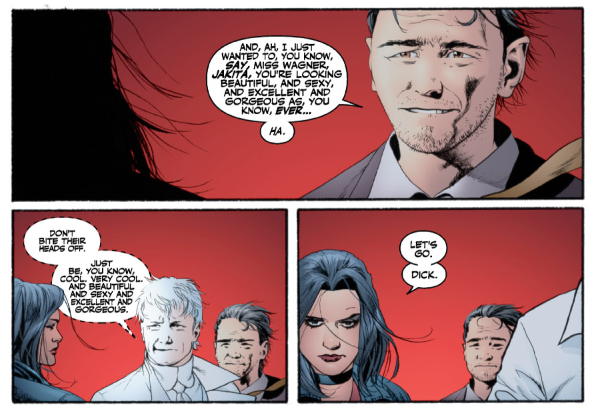
Whenever I originally read this, I didn't have the slightest clue of what Planetary even was. I merely picked up the book for three reasons - firstly, because it had Batman in it, but also because I had recently come off of writer Warren Ellis' limited run on Iron Man with the "Extremis" storyline and because John Cassaday was one of my favorite artists at the time. So the talent was there, and I was itching to see how the duo would lend it to The Dark Knight. I didn't really get lost in following the plot, despite my lack of prior knowledge about the title, but in the event that you need a little more enticement than that, here's the concept of Ellis' Planetary: essentially, Planetary focuses on three superpowered protagonists. Elijah Snow, Jakita Wagner, and a social misfit called The Drummer. Their mission, as dictated by the organization they work for, is to discover the undiscovered truths about the world's history. Some of these missions range from the fantastical to the horrifying, and investigation into inter-dimensional anomalies were a common fixture of the series. Think of it as
X-Files crossed into the more bizarre Superman stories from the fifties, and you've got a clear idea in your head of what Planetary is all about.

And this. Alot of this.
What does this have to do with Batman? Funny you should ask. In
Night on Earth, we find the three predominant Planetary field agents working a case that brings them to none other than their universe's version of Gotham City. In the first few pages, we're even treated to a humorous encounter with alternate dimensional iterations of two major characters in the Batman mythos - Dick Grayson and The Joker, who are both working as staff for Planetary's Gotham bureau. Right away, the book does a fine job of blending low-brow comedy with a deadpan serious procedural, as the awkward Grayson and gleeful "Jasper" inform them and the reader of their current case. Planetary is hunting an individual named John Black, responsible for several murders within Gotham due to a mysterious metahuman ability.
Very soon, the three find themselves heading to an iconic location from the Batman comics - a location that takes up the majority of the story, one that I won't spoil - which also served as the last known appearance of John Black. The three corner Black whenever he happens upon the scene once again, panicked and obviously mentally unsound. Just as they try to give chase to him, Black's power kicks in. His power? Temporal displacement. He can shift an entire region through the multiverse, including the very place that the three find themselves in. In a flash of light, Planetary find themselves in another universe, apart of the multiverse, and in an entirely different Gotham City. It is here where they first come across the titular Caped Crusader, whose presence becomes just as much of a focus to the team as the capture of Black.
However, it isn't so much a story about Batman, and that's why it works. It's a story about a case
surrounding Batman and his mythology - effectively, it's an outsider's perspective looking in on a character many are familiar with, coming to their own conclusions and trying to rectify the many - and I mean many - different and conflicting versions of both Batman and Gotham that they come across in the midst of their manhunt. Through the effect of temporal displacement, Ellis and Cassaday not only introduce his characters to the traditional, modern Batman, but they make good use out of some of the more famous iterations, both in visual style and characterization. There's even alot of laughs to be had, particularly whenever the group is confronted by the ultra tongue-in-cheek 1960's Adam West version of The Dark Knight.

Ultimately, however, the book's many strengths rely on singular focus. Despite his presence being a large part of the narrative, Batman himself never actually distracts from the main story and, by the end, he actually helps illuminate the team to Black's motivations. In a rather poignant way, Batman's interference shows that even though the man is in need of obvious help, the serial killer that Black represents is still a human being with his own fallacies that help paint the portrait of a man on the run because of what he is. In between a few gags here and there, particularly with the Drummer character's quirks and the halfheartedly dysfunctional team dynamic, and some whip-smart dialogue that leaves you begging for more of Ellis' take on Batman and more of his work in general, there's actually some heart behind the story that looks to both define what it means to be a victim and a perpetrator, as well as show that no matter what universe that Gotham City calls home, there will always be one constant - there's going to be a Batman to protect it.
Rating
4.5 out of 5
Reviewed by Alex Koch



